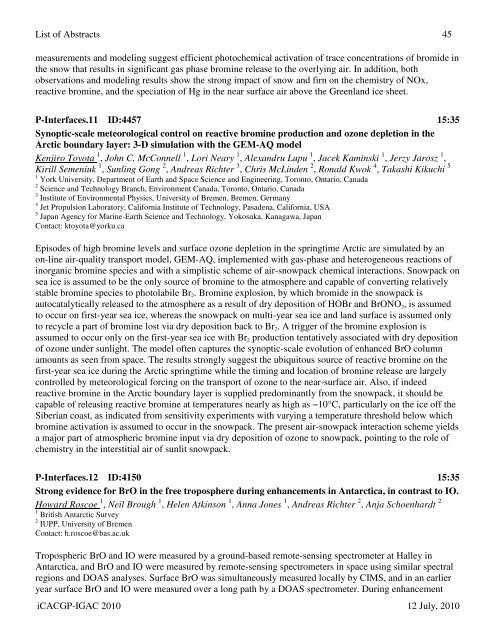Download Abstracts Here - IGAC Project
Download Abstracts Here - IGAC Project
Download Abstracts Here - IGAC Project
Create successful ePaper yourself
Turn your PDF publications into a flip-book with our unique Google optimized e-Paper software.
List of <strong>Abstracts</strong> 45measurements and modeling suggest efficient photochemical activation of trace concentrations of bromide inthe snow that results in significant gas phase bromine release to the overlying air. In addition, bothobservations and modeling results show the strong impact of snow and firn on the chemistry of NOx,reactive bromine, and the speciation of Hg in the near surface air above the Greenland ice sheet.P-Interfaces.11 ID:4457 15:35Synoptic-scale meteorological control on reactive bromine production and ozone depletion in theArctic boundary layer: 3-D simulation with the GEM-AQ modelKenjiro Toyota 1 , John C. McConnell 1 , Lori Neary 1 , Alexandru Lupu 1 , Jacek Kaminski 1 , Jerzy Jarosz 1 ,Kirill Semeniuk 1 , Sunling Gong 2 , Andreas Richter 3 , Chris McLinden 2 , Ronald Kwok 4 , Takashi Kikuchi 51 York University, Department of Earth and Space Science and Engineering, Toronto, Ontario, Canada2 Science and Technology Branch, Environment Canada, Toronto, Ontario, Canada3 Institute of Environmental Physics, University of Bremen, Bremen, Germany4 Jet Propulsion Laboratory, California Institute of Technology, Pasadena, California, USA5 Japan Agency for Marine-Earth Science and Technology, Yokosuka, Kanagawa, JapanContact: ktoyota@yorku.caEpisodes of high bromine levels and surface ozone depletion in the springtime Arctic are simulated by anon-line air-quality transport model, GEM-AQ, implemented with gas-phase and heterogeneous reactions ofinorganic bromine species and with a simplistic scheme of air-snowpack chemical interactions. Snowpack onsea ice is assumed to be the only source of bromine to the atmosphere and capable of converting relativelystable bromine species to photolabile Br 2 . Bromine explosion, by which bromide in the snowpack isautocatalytically released to the atmosphere as a result of dry deposition of HOBr and BrONO 2 , is assumedto occur on first-year sea ice, whereas the snowpack on multi-year sea ice and land surface is assumed onlyto recycle a part of bromine lost via dry deposition back to Br 2 . A trigger of the bromine explosion isassumed to occur only on the first-year sea ice with Br 2 production tentatively associated with dry depositionof ozone under sunlight. The model often captures the synoptic-scale evolution of enhanced BrO columnamounts as seen from space. The results strongly suggest the ubiquitous source of reactive bromine on thefirst-year sea ice during the Arctic springtime while the timing and location of bromine release are largelycontrolled by meteorological forcing on the transport of ozone to the near-surface air. Also, if indeedreactive bromine in the Arctic boundary layer is supplied predominantly from the snowpack, it should becapable of releasing reactive bromine at temperatures nearly as high as −10°C, particularly on the ice off theSiberian coast, as indicated from sensitivity experiments with varying a temperature threshold below whichbromine activation is assumed to occur in the snowpack. The present air-snowpack interaction scheme yieldsa major part of atmospheric bromine input via dry deposition of ozone to snowpack, pointing to the role ofchemistry in the interstitial air of sunlit snowpack.P-Interfaces.12 ID:4150 15:35Strong evidence for BrO in the free troposphere during enhancements in Antarctica, in contrast to IO.Howard Roscoe 1 , Neil Brough 1 , Helen Atkinson 1 , Anna Jones 1 , Andreas Richter 2 , Anja Schoenhardt 21 British Antarctic Survey2 IUPP, University of BremenContact: h.roscoe@bas.ac.ukTropospheric BrO and IO were measured by a ground-based remote-sensing spectrometer at Halley inAntarctica, and BrO and IO were measured by remote-sensing spectrometers in space using similar spectralregions and DOAS analyses. Surface BrO was simultaneously measured locally by CIMS, and in an earlieryear surface BrO and IO were measured over a long path by a DOAS spectrometer. During enhancementiCACGP-<strong>IGAC</strong> 2010 12 July, 2010








